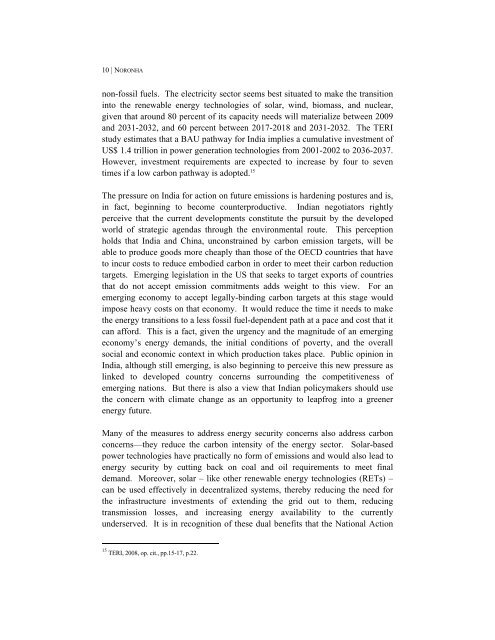Indian Climate Policy - Global Commons Institute
Indian Climate Policy - Global Commons Institute
Indian Climate Policy - Global Commons Institute
Create successful ePaper yourself
Turn your PDF publications into a flip-book with our unique Google optimized e-Paper software.
10 | NORONHA<br />
non-fossil fuels. The electricity sector seems best situated to make the transition<br />
into the renewable energy technologies of solar, wind, biomass, and nuclear,<br />
given that around 80 percent of its capacity needs will materialize between 2009<br />
and 2031-2032, and 60 percent between 2017-2018 and 2031-2032. The TERI<br />
study estimates that a BAU pathway for India implies a cumulative investment of<br />
US$ 1.4 trillion in power generation technologies from 2001-2002 to 2036-2037.<br />
However, investment requirements are expected to increase by four to seven<br />
times if a low carbon pathway is adopted. 15<br />
The pressure on India for action on future emissions is hardening postures and is,<br />
in fact, beginning to become counterproductive. <strong>Indian</strong> negotiators rightly<br />
perceive that the current developments constitute the pursuit by the developed<br />
world of strategic agendas through the environmental route. This perception<br />
holds that India and China, unconstrained by carbon emission targets, will be<br />
able to produce goods more cheaply than those of the OECD countries that have<br />
to incur costs to reduce embodied carbon in order to meet their carbon reduction<br />
targets. Emerging legislation in the US that seeks to target exports of countries<br />
that do not accept emission commitments adds weight to this view. For an<br />
emerging economy to accept legally-binding carbon targets at this stage would<br />
impose heavy costs on that economy. It would reduce the time it needs to make<br />
the energy transitions to a less fossil fuel-dependent path at a pace and cost that it<br />
can afford. This is a fact, given the urgency and the magnitude of an emerging<br />
economy’s energy demands, the initial conditions of poverty, and the overall<br />
social and economic context in which production takes place. Public opinion in<br />
India, although still emerging, is also beginning to perceive this new pressure as<br />
linked to developed country concerns surrounding the competitiveness of<br />
emerging nations. But there is also a view that <strong>Indian</strong> policymakers should use<br />
the concern with climate change as an opportunity to leapfrog into a greener<br />
energy future.<br />
Many of the measures to address energy security concerns also address carbon<br />
concerns—they reduce the carbon intensity of the energy sector. Solar-based<br />
power technologies have practically no form of emissions and would also lead to<br />
energy security by cutting back on coal and oil requirements to meet final<br />
demand. Moreover, solar – like other renewable energy technologies (RETs) –<br />
can be used effectively in decentralized systems, thereby reducing the need for<br />
the infrastructure investments of extending the grid out to them, reducing<br />
transmission losses, and increasing energy availability to the currently<br />
underserved. It is in recognition of these dual benefits that the National Action<br />
15 TERI, 2008, op. cit., pp.15-17, p.22.
















